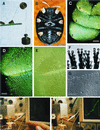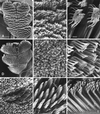Defense by foot adhesion in a beetle (Hemisphaerota cyanea)
- PMID: 10841556
- PMCID: PMC18661
- DOI: 10.1073/pnas.97.12.6568
Defense by foot adhesion in a beetle (Hemisphaerota cyanea)
Abstract
The beetle Hemisphaerota cyanea (Chrysomelidae; Cassidinae) responds to disturbance by activating a tarsal adhesion mechanism by which it secures a hold on the substrate. Its tarsi are oversized and collectively bear some 60,000 adhesive bristles, each with two terminal pads. While walking, the beetle commits but a small fraction of the bristles to contact with the substrate. But when assaulted, it presses its tarsi flatly down, thereby touching ground with all or nearly all of the bristles. Once so adhered, it can withstand pulling forces of up to 0.8 g ( approximately 60 times its body mass) for 2 min, and of higher magnitudes, up to >3 g, for shorter periods. Adhesion is secured by a liquid, most probably an oil. By adhering, the beetle is able to thwart attacking ants, given that it is able to cling more persistently than the ant persists in its assault. One predator, the reduviid Arilus cristatus, is able to feed on the beetle, possibly because by injecting venom it prevents the beetle from maintaining its tarsal hold.
Figures






References
-
- Eisner T. Verh Dtsch Zool Ges. 1972;65:123–137.
-
- Baier R E, Shafrin E G, Zisman W A. Science. 1968;162:1360–1368. - PubMed
-
- Nachtigall W. Biological Mechanisms of Attachment. New York: Springer; 1974.
-
- Walker G. Int J Adhes Adhes. 1992;13:3–7.
-
- Walker G, Yule A B, Ratcliffe J. J Zool London. 1985;205:297–307.
Publication types
MeSH terms
Grants and funding
LinkOut - more resources
Full Text Sources

